Friday dawned sunny and bright, a near perfect morning as car after car started pulling into the fairgrounds parking lot for the 2017 Boundary County Farm Bureau Farm Tour. Cassie Olson, District Manager for the Boundary Soil Conservation District, was a touch nervous; last year she helped former district manager Rene' Riddle get ready for the tour, this was her first year at the helm, though she did, she said, have a lot of help, including Rene's.
|
|
| Young Colette, 7, was smart to wear her sun hat on Friday's Farm Bureau Farm Tour. |
One group that wasn't so well represented on this year's tour were the very people those in attendance were setting out to see ... most who farm in Boundary County are too busy right now trying to make up time after a late arriving spring. Everyone who took the tour is grateful to the producers who took time out of their hectic schedule to share their time and knowledge.
On this year's tour, guests didn't see any of the big spreads that grace the county, instead focusing on small to mid-scale farms.
When all were aboard, Mike pulled out and headed the bus north, turning west at Three Mile Junction to the first stop at 2431 Moon Shadow Road, a place where Paula Rice, her family and crew raise not food or fiber, but beauty on the BeeHaven Specialty Cut Flower Farm.
Along the way, Farm Bureau chairwoman Kristi Kellogg, her husband, President John Kellogg, acting as walking public address system when not wielding the microphone himself, introduced Cassie and a few others who helped organize the tour; Boundary Soil Conservation District chairman Tom Daniel and his wife, Sandy, Daniel Tree Farm, Ree Brannon, District Soil Conservationist for the NRCS, and Bob Smathers, regional Farm Bureau manager for District 5.
Kristi also conducted the first of many prize drawings that took place throughout the day, giving away everything from Farm Bureau hats and T-shirts to picnic forks and sprayers!
Story continues below photo
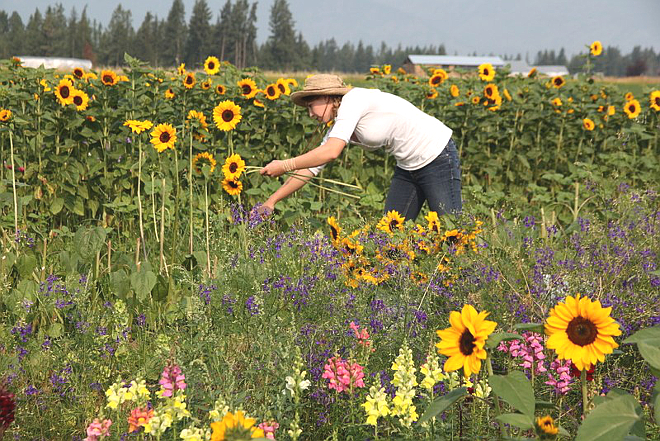 |
| While not quite as colorful as this, there are already flowers in bloom at Bee Haven Specialty Cut Flower Farm, as well as the promise of a bountiful crop of blossoms to come to grace weddings, local florist shops and more.. |
From outward appearances, BeeHaven Specialty Cut Flower Farm looks more like the home of an overly avid gardener than a commercial growing operation. Tulips, daffodils and other spring blossoms are already in bloom around the quaint white farm house, and plots of over 100 different types of flower are already up and budding with the promise of spectacular colors to come soon.
|
|
| Paula Rice |
BeeHaven might be just a small family farm, but it's part of an integral network of American flower farmers working together to regain a domestic flower market share. Around 80-percent of the flowers you see in America's florist shops are imported from far-away places and BeeHaven is one small part of a nation-wide network of mostly small family farms working together to rebuild and support flowers grown locally.
In addition to growing and nurturing beds of peonies, lavender, sunflowers and much more on the 10-acre farmstead, about three acres of which are planted in flowers, Paula and her crew also take the blossoms they grow and harvest and arrange them into stunning seasonal floral displays, bouquets, corsages, boutonnieres and more. They even deliver their fresh flowers locally, May through September!
Plus, they impart time-tested methods to ensure that the BeeHaven blooms you buy stay fresh and vibrant for the longest possible time and even hold workshops and classes to teach you the joys of flowers.
To learn more about BeeHaven Specialty Cut Flower Farm, visit www.beehavenfarm.com, visit on Facebook, or call (208) 267-1160.
Story continues below photo
|
|
| Simon Ronniger shows the state-of-the-art potato cellar at Ronniger's Organics. |
After bidding Paula farewell, the caravan headed back to Three Mile Junction and continued east, all the way to 7312 Perkins Lake Road, just this side of the Montana line, to pay a visit to Simon and Marqui Ronniger, the second generation to operate the mid-sized certified organic vegetable farm at Ronniger's Organics, where they grow most everything but specialize in some delicious root crops.
|
|
| Simon and Marqui Ronniger with NCRS Soil Conservationist Ree Brannon, the latest of a line of NCRS personnel to help make Ronniger's one of the most innovative organic farms anywhere. |
One day, Simon hopes to do as his dad did, take his son, Strummer, under his wing, and pass along the lessons both he and his father learned over the course of years. Already, Strummer shows a keen interest, helping out in all the ways he's able, sometimes with mom, others with dad and quite often, too, with grandpa.
About 35 to 40 acres of Ronniger's is under production in a given year, and to the large scale producer, that might not sound like much. But much of what's done on those acres is labor-intensive, much of it by hand. As Simon said, finding equipment designed for a mid-sized operation is difficult, and much of the gear used he has to fabricate or customize himself.
They have a dedicated crew who enjoy benefits equal to or better than hands on most large scale operations, and each year interns interested in learning from the masters line up for the opportunity to work on Ronniger's farm. The work is often back breaking, but Simon, like his father, is as dedicated to his employees as they are to their land and crops, and they work fewer and more flexible hours than crews on most farms, even when the work to be done is at its longest and hardest.
Simon mixed good humor with an expert's knowledge and kept his guests rapt as he led the way through the storage cellars and farm store then out to the fields where this year's crop is already up and putting on true leaves. Marqui takes the microphone on occasion as John Kellogg dutifully carts along the loudspeaker, and Ree occasionally takes over to explain some of the NCRS programs she's helped bring to Ronniger's Organics, such as the high tunnel hoop house built recently that will soon help extend the growing season.
And while much of the crop harvested at Ronniger's is sent out to ports around the globe, hardly a Saturday goes by during the season from May through October that Simon, Marqui and Strummer don't pack up what's in season and head to Sandpoint from 9 a.m. to 1 p.m. for the Sandpoint Farmers Market, where they share tips and tricks or just visit.
To find out more about Ronniger's Organics, visit them on Facebook, call (208) 627-8181 or email ronnigersorganics@gmail.com.
Story continues below photos
|
|
| Not only did Cassie Olson (back, facing camera, arms folded, lead the task of organizing this year's Farm Bureau Farm Tour, she also made and packed an incredible lunch for everyone, served up at the Curley Creek Community Hall. "It was a little crazy," she said modestly, "but I love cooking for a crowd!" |
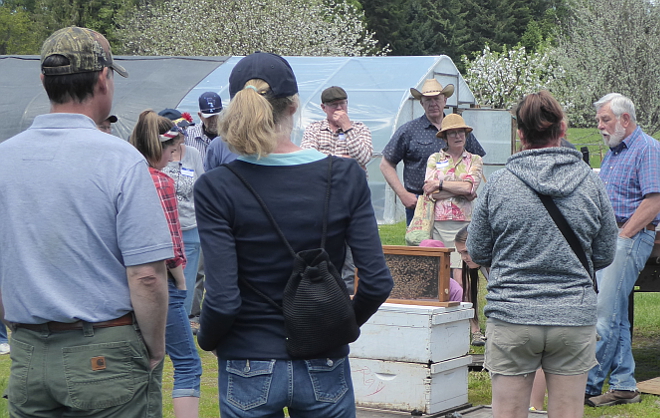 |
| Ray Chaffee, right, imparts just a wee bit of the wisdom and lore he's acquired in over 45 years of North Idaho beekeeping as guests get a first-hand glimpse of what bees in a hive look like. |
After an outstanding lunch at the Curley Creek Community Hall prepared by the amazing Cassie Olson, most guests simply walked to the next stop on the tour, Curley Creek Honey, right next door at Ray Chafee's house, 7225 Old Highway 2 Loop.
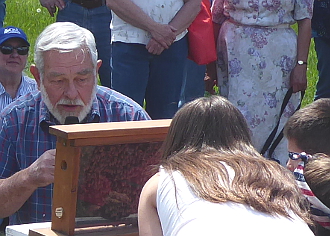 |
| Ray Chaffee kept both children and adults entertained and educated on the wonderful world of bees and beekeeping. |
He pointed out the abundance of dandelions in bloom around his place, part of them there on purpose, he said, the rest because he simply ran out of time. The bees assiduously visit the blossoms, and through a process downright mystical to most, turn the nectar of this and other flowers, on the Chaffee place, including two acres of clover, into one of the most loved and longest lasting of all food products.
Man has been enjoying the sweet taste of honey for more than 8,000 years, as proven by a cave painting in Valencia, Spain, that's at least that old, depicting people foraging for honey, and sealed containers of honey over a thousand years old have been opened and savored as if the bees that produced it were still alive today.
Ray came to North Idaho in 1972, and in 1975 he bought 400 hives. He's slowed down just a little in all the years since, liking to run a mere 100 each year now, each producing an average of 45-pounds of honey a season.
While the adults in attendance were fascinated by Ray's conversational discourse and incredible knowledge of bees, the younger members of the crowd couldn't seem to get enough of the glass-sided super in which a few of Ray's bees tended the queen, exclaiming excitedly when they spotted her among all the wiggling bee bodies.
While showing the way to use the smoker and other tools of the trade and demonstrating how the hive boxes and supers go together, Ray answered myriad questions and explained everything from how a new hive gets its bees to how far a bee might forage in search of nectar (eight miles), not only gathering the food that will keep the hive alive through winter and see that the next generation gets off to a good start, but doing the plants themselves the essential service of pollination, helping to assure that the next generation of flowers is there to blossom next year.
Story continues below photo
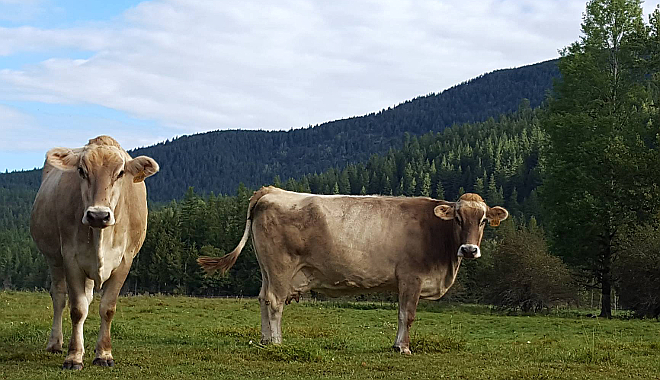 |
| It's a slightly incongruous sight to be driving in what may be the most remote stretch on the Boundary County road system and come face to face with a herd of Brown Swiss milch cows! |
After bidding the Chaffees farewell, the Farm Bureau caravan loads up and heads out for the day's final stop, heading west on Old Highway 2 Loop before turning north and heading deeper and deeper into the woods. The "You are in Grizzly Country" sign lets you know you're not quite nowhere, but if you stand up tall and stretch a mite, you can likely see it from there.
|
|
| Erik Peters, left, and Brad Miller manage the day to day chores of running Springs of Hope Creamery and Ranch, Erik tending to the cattle to provide the milk, Brad seeing to turning that fresh whole milk into a variety of dairy products. |
A further irony is that this pastoral place is located right at the foot of Goat Mountain.
And despite the overwhelming grizzly sign (pun intended), you'll see the stars of the operation, 40 head of cattle, 25 of them sloe-eyed brown Swiss dairy cows grazing bucolically, the cattle responsible for producing the milk that the Springs of Hope crew transform into high-quality products that can be found on grocery shelves throughout North Idaho. To date, the bear and the cows have not had any run ins.
Sam and Danielle Wray bought the ranch in 2008, not with the idea of opening a creamery, but to start a German Baptist Brethren youth ministry on the quiet 196 acre spread of timberland and pasture.
Sam and Danielle bought one cow, Bessie, in 2009.
Initially, Sam and Danielle established a boys' ranch, and Bessie was brought in to teach and help the boys learn. But word got out of the fine dairy products they produced at the ranch after their nearest neighbor two miles away sampled some and encouraged them to put their product on the shelves at Sharon's Country Store just north of Three Mile Junction.
"The need continued to grow and we went over, milking three cows and then we had to get grade A certified," said Wray's son-in-law Brad Miller, who now manages the creamery end of the business, overseeing the production of dairy and creamery products. "From there we continued to grow and we are now milking 25 cows."
Eventually, changes in Idaho law prompted the family to abandon the boys' ranch, and the main focus since has been the creamery. Springs of Hope coddles their cattle, providing ample fresh spring water, rotating them from pasture to pasture to ensure they have good fresh grass. They raise and put up their own hay, and recycle manure to fertilize the fields.
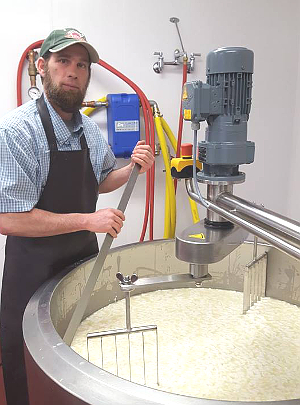 |
| Brad Miller working to turn fresh raw milk into a variety of wholesome and tasty dairy products, from cheese to butter to kefir. |
From their distant next door neighbor two miles yon to Sharon's, the number of stores carrying Springs of Hope Creamery products has grown to include all North Idaho Super 1 stores, Yoder's Grocery in Bonners Ferry, Winter Ridge Market, Yoke's Fresh Market and Miller's Country Store in Sandpoint and Pilgrim's Natural Food Market in Coeur d'Alene.
You can learn more about Springs of Hope Creamery and Ranch on their Facebook page, (their website is currently being revamped and is temporarily off line), or by calling (208) 267-2273. Visitors are welcome, but if you wind up nowhere, you've gone a little too far!
At the end of the day, Cassie was tired but happy. Everything went smooth and everyone, both the guests and the farmers they visited, had a good experience and a wonderful time.
"I love my job so much and this was a huge highlight for me," she said. "I work and partner with so many amazing people and today really brought that to light! Paula Rice, her gorgeous flower farm and her wonderful crew at BeeHaven, Simon and Marqui Ronniger and their incredible organic farm, Ray Chaffee with Curley Creek Honey and then the spectacular tour of Springs of Hope Ranch and Creamery! It was a wonderful day. Everything from the weather, the company, and the venues, to all of the lovely treats along the way ... I love our community and I love what a diverse agricultural community we have!"
In fact, as the day ended, she was already thinking ahead to next year and how to handle what turned out to be the hardest part of arranging this year's tour, telling so many that there just wasn't any more room.
"I hated having to turn people away," she said.
|
|
Cassie Olson, right, was up bright and early to attend her first farm tour as main organizer, and despite her initial jitters, there's no way the day could have turned out much better. |
| Even though it's still early spring thanks to its late start this year, Paula Rice's peonies at BeeHaven are already almost waist high and beginning to bud, assuring that passers-by will soon be seeing amazing splashes of color! |
|
|
|
And even though most flowers have yet to bloom, the early spring flowers, including these tulips, are already in blossom, a welcome sight after a long, wet winter. |
| Simon Ronniger gets into the finer points of raising root crops, especially the potatoes his farm, Ronniger's Organics, is famous for. Behind him is the high tunnel hoop house that will, once he gets used to it, extend his growing season. |
|
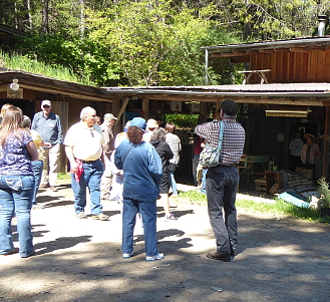 |
Guests visit one of the root cellars at Ronniger's Organics, left, and Ronniger's Country Store, where folks can buy great food, seed potatoes and more. |
| While the older crowd was most interested in the technical details of beekeeping during their visit to Curley Creek Honey, the younger crowd couldn't get enough of watching the bees at work in a glass-sided super. |
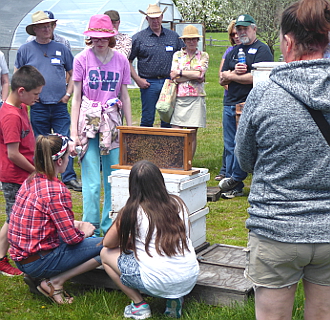 |
|
|
Ray Chaffee's vast knowledge of bees and beekeeping, coupled with his gracious manner and great good humor, made the tour group's visit to his farm a highlight of the day. |
| From the young calves, including this two week old Brown Swiss bull ... |
|
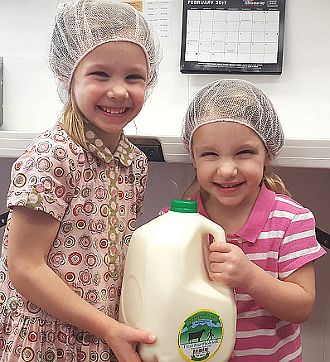 |
... to the darling young ladies who do all they can to pitch in and help, a visit to Springs of Hope Creamery and Ranch is sure to provide you with more than your recommended daily dose of cuteness! |
| And the samples, such as the huckleberry ice cream the crew generously scooped out for those on the tour, are certain to tantalize your taste buds, as Dylan and Makenna Olson can readily attest! |
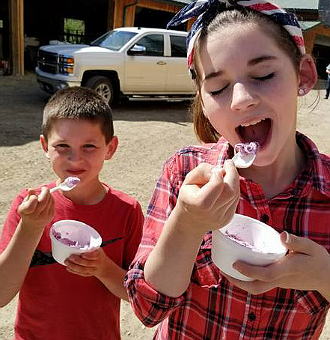 |